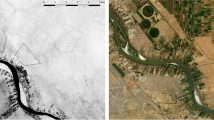Abstract
The goal of this project is to identify unmarked burials inside the known limits of a historic cemetery and unmarked slave burials adjacent to the cemetery to answer questions regarding variability in treatment of slaves by slave owners. This project used three geophysical prospection methods (electromagnetic induction/conductivity, ground penetrating radar, and magnetic susceptibility) to image the subsurface and locate unmarked graves. The results indicate that up to 21 possible unmarked graves exist at the Prior Cemetery. The survey detected 17 with two or more geophysical techniques and four with a single technique. Nine possible unmarked graves were tested with a metal probe. Every tested anomaly revealed less compact soils indicative of an unmarked grave.
















Similar content being viewed by others
References
Annan AP (2009) Electromagnetic principles of ground penetrating radar. In: Jol HM (ed) Ground penetrating radar: theory and applications. Elsevier, Amsterdam, pp 3–40
Bevan BW (1983) Electromagnetics for mapping buried earth features. J Field Archaeol 10:47–54
Bevan BW (1991) The search for graves. Geophysics 56:1310–1319
Bigman DP (2012) The use of electromagnetic induction in locating graves and mapping cemeteries: an example from native North America. Archaeol Prospect 19:31–39
Brooks C (2011) Enclosing their immortal souls: a survey of two African American cemeteries in Georgetown, South Carolina. Southeast Archaeol 30:176–186
Brown JA (1971) The dimensions of status in the burials at Spiro. In: Brown JA (ed) Approaches to the social dimensions of mortuary practices, Memoir 25. Society of American Archaeology, Washington D.C, pp 92–112
Conyers LB (2004) Ground-penetrating radar for archaeology. Alta Mira Press, Lanham
Conyers LB (2006) Ground-penetrating radar techniques to discover and map historic graves. Hist Archaeol 40:64–73
Conyers LB, Leckebusch J (2010) Geophysical archaeology research agendas for the future: some ground-penetrating radar examples. Archaeol Prospect 17:117–123
Dalan RA (2006) A geophysical approach to buried site detection using down-hole susceptibility and soil magnetic techniques. Archaeol Prospect 13:182–206
Dalan RA (2008) A review of the role of magnetic susceptibility in archaeogeophysical studies in the USA: recent developments and prospects. Archaeol Prospect 15:1–31
Dalan RA, De Vore SL, Clay RB (2010) Geophysical identification of unmarked historic graves. Geoarchaeology 25:572–601
Davenport GC (2001) Remote sensing applications in forensic investigations. Hist Archaeol 35:87–100
Davidson JM, Mainfort RC Jr (2011) Hidden differences beneath a surface equality: mortuary variability in two late-nineteenth-century cemeteries in Crawford County, Arkansas. Southeast Archaeol 30:203–214
Dionne CA, Wardlaw DK, Schultz JJ (2010) Delineation and resolution of cemetery graves using a conductivity meter and ground-penetrating radar. Tech Briefs Hist Archaeol 5:20–30
Fiedler S, Illich B, Berger J, Graw M (2009) The effectiveness of ground-penetrating radar surveys in the location of unmarked burial sites in modern cemeteries. J Appl Geophys 68:380–385
Giles B, Bauder J, Alfonso-Durruty MP (2010) Revisiting the dead at Helena Crossing, Arkansas. Southeast Archaeol 29:323–340
Gleason P, Smith L, Goffinet C, White N, Harrivel G, Hinga B (2011) Detecting graves in a lime marl environment: a comparison of soil resistivity and ground penetrating radar methods. Symp Appl Geophys Eng Environ Probl 2011:226
Goodman D, Piro S, Nishimura Y, Schneider K, Hongo H, Higashi N, Steinberg J, Damiata B (2009) GPR archaeometry. In: Jol HM (ed) Ground penetrating radar: theory and applications. Elsevier, Amsterdam, pp 479–508
Hally DJ (2008) King: the social archaeology of a Late Mississippian Town in Northwestern Georgia. University of Alabama Press, Tuscaloosa
Hays CT (2010) Adena mortuary patterns in central Ohio. Southeast Archaeol 29:106–120
Honerkamp N, Crook R (2012) Archaeology in a Geechee graveyard. Southeast Archaeol 31:103–114
Hunter D (2012) The Mala MIRA at the Wallaga Lake Aboriginal Cemetery. ISAP News 31:2–4
Jones G (2008) Geophysical mapping of historic cemeteries. Tech Briefs Hist Archaeol 3:25–38
Koppenjan S (2009) Ground penetrating radar systems and designs. In: Jol HM (ed) Ground penetrating radar: theory and applications. Elsevier, Amsterdam, pp 73–97
Linford NT (2004) Magnetic ghosts: mineral magnetic measurements on Roman and Anglo-Saxon graves. Archaeol Prospect 11:167–180
Mallios S, Caterino DM (2011) Mortality, money, and commemoration: social and economic factors in Southern California grave-marker change during the nineteenth and twentieth centuries. Int J Hist Archaeol 15:429–460
Murphy EM (2011) Children’s burial grounds in Ireland (Cillini) and parental emotions toward infant death. Int J Hist Archaeol 15:409–428
Nobes DC (1999) Geophysical surveys of burial sites: a case study of the Oaro urupa. Geophysics 64:357–367
Peebles CS (1971) Moundville and surrounding sites: some structural considerations of mortuary practices II. In: Brown JA (ed) Approaches to the social dimensions of mortuary practices, Memoir 25. Society of American Archaeology, Washington D.C, pp 68–91
Shaaban FA, Abbas AM, Atya MA, Hafez MA (2009) Ground-penetrating radar exploration for ancient monuments in the valley of mummies—Kilo 6, Bahariya Oasis, Egypt. J Appl Geophys 68:194–202
Sjostrom K, Ryerson K, Watson J, Bock D, Rush D (2009) Geophysical mapping of an entire municipal cemetery. Symp Appl Geophys Eng Environ Probl 2009:1032–1041
Thompson VD, Arnold PJ III, Pluckhahn TJ, Vanderwarker AM (2011) Situating remote sensing in anthropological archaeology. Archaeol Prospect 18:195–213
Torgashov E, Anderson N (2012) Locating unmarked graves in historic cemeteries using ground penetrating radar. Symp Appl Geophys Eng Environ Probl 2012:125
Witten AJ (2006) Handbook of geophysics and archaeology. Equinox Publishing Ltd., London
Acknowledgments
I would like to thank Edwin Prior for funding this project and his inclination toward protecting our shared heritage. I would also like to extend my gratitude to Travis Jones for his help in carrying out the survey and his assistance in processing the data. Gail Tarver graciously lent her expertise and guidance, and provided the probe used to ground truth anomalies. Finally, I would like to thank Robert Hawman, Stefan Brannan, and two anonymous reviewers for commenting on an earlier version of the paper. Their thoughtful comments significantly improved the final product.
Author information
Authors and Affiliations
Corresponding author
Rights and permissions
About this article
Cite this article
Bigman, D.P. Mapping social relationships: geophysical survey of a nineteenth-century American slave cemetery. Archaeol Anthropol Sci 6, 17–30 (2014). https://doi.org/10.1007/s12520-013-0119-6
Received:
Accepted:
Published:
Issue Date:
DOI: https://doi.org/10.1007/s12520-013-0119-6




